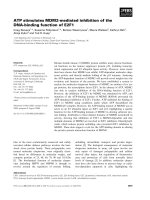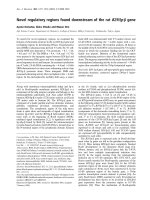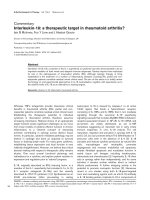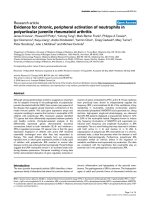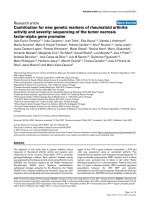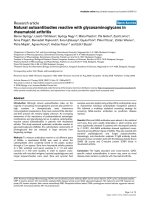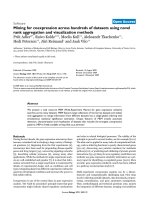Báo cáo y học: "Contribution for new genetic markers of rheumatoid arthritis activity and severity: sequencing of the tumor necrosis factor-alpha gene promoter" docx
Bạn đang xem bản rút gọn của tài liệu. Xem và tải ngay bản đầy đủ của tài liệu tại đây (269.78 KB, 10 trang )
Open Access
Available online />Page 1 of 10
(page number not for citation purposes)
Vol 9 No 2
Research article
Contribution for new genetic markers of rheumatoid arthritis
activity and severity: sequencing of the tumor necrosis
factor-alpha gene promoter
João Eurico Fonseca
1,2
, João Cavaleiro
1
, José Teles
1
, Elsa Sousa
1,2
, Valeska L Andreozzi
3
,
Marília Antunes
4
, Maria A Amaral-Turkman
4
, Helena Canhão
1,2
, Ana F Mourão
1,5
, Joana Lopes
1
,
Joana Caetano-Lopes
1
, Pamela Weinmann
1
, Marta Sobral
1
, Patrícia Nero
5
, Maria J Saavedra
6
,
Armando Malcata
6
, Margarida Cruz
7
, Rui Melo
8
, Araceli Braña
9
, Luis Miranda
10
, José V Patto
10
,
Anabela Barcelos
11
, José Canas da Silva
12
, Luís M Santos
13
, Guilherme Figueiredo
13
,
Mário Rodrigues
14
, Herberto Jesus
14
, Alberto Quintal
14
, Teresa Carvalho
15
, José A Pereira da
Silva
2
, Jaime Branco
5
and Mário Viana Queiroz
2
1
Rheumatology Research Unit, Instituto de Medicina Molecular, Faculdade de Medicina, Universidade de Lisboa, Av. Professor Egas Moniz, 1649-
028, Lisboa, Portugal
2
Santa Maria Hospital, Av. Professor Egas Moniz, 1649-035, Lisboa, Portugal
3
Escola Nacional de Saúde Pública Sérgio Arouca, R. Leopoldo Bulhões, 1480, 21031-210, Rio de Janeiro, Brasil
4
Centro de Estatística e Aplicações, Faculdade de Ciências, Universidade de Lisboa, Campo Grande, 1749-016, Lisboa, Portugal
5
Egas Moniz Hospital, Rua da Junqueira, 126, 1349-019, Lisboa, Portugal
6
Coimbra University Hospital, Praceta Mota Pinto, 3000-075, Coimbra, Portugal
7
Faro Hospital, Rua Leão Penedo, 8000-386, Faro, Portugal
8
Nossa Senhora da Assunção Hospital, Rua D. Alexandrina Soares de Albergaria, 6270-498, Seia, Portugal
9
Caldas da Rainha Hospital, Largo Rainha Dona Leonor, 2500-176, Caldas da Rainha, Portugal
10
Portuguese Institute of Rheumatology, Rua da Beneficência, 7, 1050-034, Lisboa, Portugal
11
Infante D. Pedro Hospital, Avenida Artur Ravara, 3814-501, Aveiro, Portugal
12
Garcia de Orta Hospital, Av. Torrado da Silva, 2801-951, Almada, Portugal
13
Divino Espírito Santo Hospital, Praça 5 de Outubro, 9500, Ponta Delgada, Portugal
14
Funchal Central Hospital, Avenida Luís de Camões, 9000, Funchal, Portugal
15
Cell Biology Unit, Instituto de Medicina Molecular, Faculdade de Medicina, Universidade de Lisboa, Av. Professor Egas Moniz, 1649-028, Lisboa,
Portugal
Corresponding author: João Eurico Fonseca,
Received: 30 Dec 2006 Revisions requested: 12 Feb 2007 Revisions received: 2 Mar 2007 Accepted: 4 Apr 2007 Published: 4 Apr 2007
Arthritis Research & Therapy 2007, 9:R37 (doi:10.1186/ar2173)
This article is online at: />© 2007 Fonseca et al.; licensee BioMed Central Ltd.
This is an open access article distributed under the terms of the Creative Commons Attribution License ( />),
which permits unrestricted use, distribution, and reproduction in any medium, provided the original work is properly cited.
Abstract
The objective of this study was to assess whether clinical
measures of rheumatoid arthritis activity and severity were
influenced by tumor necrosis factor-alpha (TNF-
α
) promoter
genotype/haplotype markers. Each patient's disease activity
was assessed by the disease activity score using 28 joint counts
(DAS28) and functional capacity by the Health Assessment
Questionnaire (HAQ) score. Systemic manifestations,
radiological damage evaluated by the Sharp/van der Heijde
(SvdH) score, disease-modifying anti-rheumatic drug use, joint
surgeries, and work disability were also assessed. The promoter
region of the TNF-
α
gene, between nucleotides -1,318 and
+49, was sequenced using an automated platform. Five
hundred fifty-four patients were evaluated and genotyped for 10
single-nucleotide polymorphism (SNP) markers, but 5 of these
markers were excluded due to failure to fall within Hardy-
Weinberg equilibrium or to monomorphism. Patients with more
than 10 years of disease duration (DD) presented significant
associations between the -857 SNP and systemic
manifestations, as well as joint surgeries. Associations were also
found between the -308 SNP and work disability in patients with
ACR = American College of Rheumatology; DAS28 = disease activity score using 28 joint counts; DD = disease duration; DMARD = disease-mod-
ifying anti-rheumatic drug; EM = expectation-maximization; ESR = erythrocyte sedimentation rate; HAQ = Health Assessment Questionnaire; NF-κB
= nuclear factor-kappa-B; PCR = polymerase chain reaction; RA = rheumatoid arthritis; RF = rheumatoid factor; SNP = single-nucleotide polymor-
phism; SvdH = Sharp/van der Heijde; TNF-α = tumor necrosis factor-alpha.
Arthritis Research & Therapy Vol 9 No 2 Fonseca et al.
Page 2 of 10
(page number not for citation purposes)
more than 2 years of DD and radiological damage in patients
with less than 10 years of DD. A borderline effect was found
between the -238 SNP and HAQ score and radiological
damage in patients with 2 to 10 years of DD. An association was
also found between haplotypes and the SvdH score for those
with more than 10 years of DD. An association was found
between some TNF-
α
promoter SNPs and systemic
manifestations, radiological progression, HAQ score, work
disability, and joint surgeries, particularly in some classes of DD
and between haplotypes and radiological progression for those
with more than 10 years of DD.
Introduction
Tumor necrosis factor-alpha (TNF-α) has been shown to be
relevant for the physiopathology of rheumatoid arthritis (RA),
and its inhibition by anti-TNF-α antibodies or recombinant sol-
uble receptors results in a major improvement of this disease
[1]. On the other hand, TNF-α production shows a wide varia-
tion, with high- and low-producer phenotypes present in
humans [2] but with a strong concordance in monozygotic
twins [3], pointing to the influence of genetic variation on the
regulation of TNF-α circulating levels. These arguments have
favored the view that genetic factors controlling TNF-α could
have a major impact on RA outcome. An extensive network of
gene products is involved in the production, modulation, and
decay of TNF-α, affecting the stabilization of the transcripts,
full activation of membrane-bound TNF-α by proteases, and
the interaction with its membrane receptors and with mem-
brane-shedded receptors [4]. In addition, the gene itself and/
or its promoter area could be the source of genetic variation.
However, present knowledge suggests that the highest
genetic variability is concentrated in the promoter area of the
TNF-
α
gene, where at least eight different single-nucleotide
polymorphisms (SNPs) are concentrated, with the potential to
affect the binding of transcriptor factors and thus to control the
activity of the promoter and resulting mRNA and protein levels
[4].
Several studies have addressed the issue of TNF-
α
gene pro-
moter SNPs and RA outcome. Although some contradictory
results have emerged, the data published so far indicate the
possible existence of TNF-
α
gene promoter variants that act
as markers for disease severity and response to treatment in
RA [5-7]. Nevertheless, further investigation is necessary to
determine whether the previously identified TNF-
α
gene pro-
moter variants contribute directly to RA outcome or act as
genetic markers of other polymorphisms in the TNF-
α
gene
promoter area.
In this study, we have analyzed the promoter region of the
TNF-
α
gene, between nucleotides -1,318 and +49, of 554
patients with RA from 11 Portuguese rheumatology centers
serving the mainland and Azores and Madeira Islands. An
association was found between some SNPs, localized in the -
238, -308, -857, and -863 positions, and systemic manifesta-
tions, functional status, radiological damage, work disability,
and joint surgeries and between haplotypes and radiological
damage for those with more than 10 years of disease duration
(DD).
Materials and methods
Patients
Patients included in this study (n = 554) fulfilled the American
College of Rheumatology (ACR) 1987 revised criteria for RA
[8]. Research was carried out in compliance with the Declara-
tion of Helsinki. Written informed consent was obtained from
all patients, and all of the ethics committees of the participat-
ing hospitals approved the study. Patients were randomly
selected and evaluated at Santa Maria Hospital (Lisbon), Egas
Moniz Hospital (Lisbon), Coimbra University Hospital (Coim-
bra), Faro Hospital (Faro), Nossa Senhora da Assunção Hos-
pital (Seia), Caldas da Rainha Hospital (Caldas da Rainha),
the Portuguese Institute of Rheumatology (Lisbon), Infante D.
Pedro Hospital (Aveiro), Garcia de Orta Hospital (Almada),
Divino Espírito Santo Hospital (Ponta Delgada), and Funchal
Central Hospital (Funchal). For every patient included in this
study, detailed data were collected in a separate clinical
record [9]: DD, age of onset, rheumatoid factor (RF), erythro-
cyte sedimentation rate (ESR) and C-reactive protein at the
time of evaluation, the number of previous disease-modifying
anti-rheumatic drugs (DMARDs), the use of anti-TNF-α treat-
ments, the dose of prednisolone, previous joint surgeries due
to inflammatory destructive arthropathy directly related to RA
(total joint replacement and arthrodesis), the number of years
of education, and work disability (defined as the legal incapac-
ity to work as judged by an official medical committee and
directly attributed to the consequences of RA). Patients were
considered to have systemic manifestations if at least one of
the following clinical features could be detected: subcutane-
ous nodules, pulmonary fibrosis confirmed by chest roentgen-
ograms and lung function tests, echocardiographic evidence
of pericardial effusion, pleural effusion shown by chest roent-
genograms, Felty syndrome (less than 2 × 10
9
/l granulocytes
and splenomegaly), cutaneous vasculitis (leukocytoclastic
vasculitis histologically proved), non-compressive neuropathy
confirmed by electromyography, or the diagnosis of Sjögren
syndrome based on the clinical symptoms of dry eyes and dry
mouth (confirmed by a positive Schirmer's test and/or kerato-
conjunctivitis sicca with involvement of salivary glands docu-
mented by positive lip biopsy and/or salivary scintigraphy).
Simple x-rays of the hands and feet were analyzed with the
Sharp/van der Heijde (SvdH) method [10]. Disease activity
was evaluated according to the core disease activity parame-
ters proposed by the ACR and the European League Against
Rheumatism: number of swollen and tender joints, pain as
evaluated by the patient in a 10-cm analogue scale, disease
activity as evaluated by the patient and the physician in a 10-
Available online />Page 3 of 10
(page number not for citation purposes)
cm analogue scale, ESR, and Health Assessment Question-
naire (HAQ) score [11]. The disease activity score using 28
joint counts (DAS28) [12] was calculated. The presence of
other RA cases in the family was recorded if confirmed by a
rheumatologist.
Genotyping for polymorphisms
Genomic DNA was extracted from heparin anticoagulated
whole blood, after sedimentation at room temperature, using
the commercial kit QIAamp
®
DNA blood mini kit (QIAGEN
Inc., Valencia, CA, USA) according to the manufacturer's
instructions. For the TNF-
α
promoter nucleotide sequencing,
a 1,367-base pair fragment of the TNF-
α
5' flanking region,
spanning from position -1,318 to +49, was amplified by
polymerase chain reaction (PCR), using the forward primer
F1: 5'-GAAAGCCAGCTGCCGACCAG-3' and the reverse
primer R1: 5'-CCCTCTTAGCTGGTCCTCTGC-3', designed
according to human TNF-
α
sequence (gi:27802684). PCRs
were performed in a 50-μl reaction volume, using 10 μM of
each primer, 5 μl of 10× reaction buffer [160 mM (NH
4
)
2
SO
4
,
670 mM Tris-HCl (pH 8.8), 0.1% Tween-20] (Bioline Ltd.,
London, UK), 1.5 mM MgCl
2
, 0.2 mM dNTPs, and 1 U of Bio-
Taq polymerase (Bioline Ltd.). A 100-ng aliquot of genomic
DNA was denatured for 5 minutes at 94°C followed by 35
cycles of amplification (45 seconds at 95°C, 45 seconds at
66°C, and 45 seconds at 72°C) and a final extension step at
72°C for 10 minutes. PCR products were subsequently puri-
fied trough incubation with 1 U of ExoSAP-IT (Amersham, now
part of GE Healthcare, Little Chalfont, Buckinghamshire, UK)
at 37°C for 15 minutes and then at 80°C for an additional 15
minutes. All of the thermal reactions took place in 96-well
microtiter plates on a T1 Thermocycler (Biometra, Goettingen,
Germany).
DNA direct sequence analysis was carried out with a BigDye
®
Terminator version 3.1 Cycle Sequencing Kit (Applied Biosys-
tems, Foster City, CA, USA) according to the manufacturer's
instructions. A 300-ng aliquot of DNA template and the inter-
nal overlap primers F2: 5'-TGTGACCACAGCAATGGG-
TAGG-3', F3: 5'-CCAAACACAGGCCTCAGGACTC-3', and
R5: 5'-GAAAGCTGAGTCCTTGAGGGAG-3' were used.
Sequencing reactions were carried out with an initial step of 1
minute at 96°C, followed by one cycle of 96°C for 10 seconds
and 60°C for 4 minutes (25 times). Purification of sequencing
reactions was performed by ethanol precipitation. The purified
reaction mixture was analyzed on a four-capillary automated
sequencer ABI PRISMR 3100-Avant Genetic Analyzer
(Applied Biosystems) with Sequencing Analysis Software ver-
sion 5.2 (Applied Biosystems).
Statistical analysis
Multiple linear regression models were used to assess the
association between the five polymorphisms and DAS28 and
HAQ score. For systemic manifestations, work disability, joint
surgeries, and RF, logistic regression models were used
instead. All the analyses were adjusted for the effects of socio-
demographic and clinical covariates. Except for RF, the mod-
els were stratified by DD (less than 2 years, 2 to 10 years, and
more than 10 years). In regression models, SNPs were sepa-
rated into two groups: more prevalent homozygous versus het-
erozygous (aggregated with the less prevalent homozygous).
SvdH score is known to be strongly associated with DD. To
estimate the distribution of the SvdH score in the three differ-
ent age groups, a hierarchical Bayesian model was built [13].
For each group, the SvdH score was considered to follow a
gamma distribution with a shape parameter equal to 3 and
scale parameter β
i
, i = 1, 2, 3, with i representing the groups.
These β
i
values were supposed to be independent a priori with
a non-informative distribution. The group distribution was con-
sidered to be categorical with probabilities π
1
, π
2
, and π
3
fol-
lowing a prior Dirichlet distribution. These estimated
probability curves (predictive conditional densities of the
score) for the scores are essentially descriptive and should not
be used for classification purposes. These curves are
expected, one at a time as the SvdH score value increases, to
exhibit higher values than the other two curves. The points at
which the curves intersect can be seen as cutoff points. As
can be seen in Figure 1, two cutoff points are expected to be
found. The cutoff points found are 85 and 115, meaning that
SvdH score values below 85 are more likely to occur in the first
group, values between 85 and 115 are more likely to occur in
the second group, and values above 115 are more likely to
occur in the third group. Conversely, for classification pur-
poses, the SvdH score of a particular patient can be used to
calculate the conditional probability of his or her belonging to
a given group and, once this has been done for each group, to
classify the patient in the group for which the conditional prob-
ability is highest. These calculations take into account the way
the patients distribute along the groups, namely the weight of
each group in the sample. The predictive probability of the
group as a function of the SvdH score (Figure 2a) showed that
patients with less than 2 years and those with 2 to 10 years of
DD could not be separated into two groups by any SvdH
score cutoff point. The method classifies them all as belonging
to the second group. However, an SvdH score close to 90
points could distinguish two groups: patients with less than 10
years and those with more than 10 years of DD. The patients
were then separated into these two groups and distributions
were recalculated. The value of 110 points was found to be a
sensible choice for the cutoff point for the SvdH score (Figure
2b). This cutoff point was confirmed using the cross-validation
procedure by dividing the available dataset into an experimen-
tal group (2/3 of the data) and a test group (1/3). This
approach allowed us to classify the patient as having a 'good
prognosis,' as having an 'expected evolution of the disease,' or
as having a 'bad prognosis.' Table 1 shows that this cutoff
point classified 67.4% of the patients as having had a disease
course as theoretically expected (long DD and high SvdH
score or short DD and low SvdH score), 20.6% as having had
Arthritis Research & Therapy Vol 9 No 2 Fonseca et al.
Page 4 of 10
(page number not for citation purposes)
a disease course milder than theoretically expected, possibly
revealing a subset of patients with good prognosis (long DD
and low SvdH score), and 12.0% as having had a disease
course worse than theoretically expected, possibly depicting a
subset of patients with bad prognosis (short DD and high
SvdH score). Generalized linear models with gamma distribu-
tion and logarithmic link function were used to study the asso-
ciation between genotypes and SvdH score, also adjusted for
the effects of socio-demographic and clinical covariates.
All SNP analyses, including conformance with Hardy-Wein-
berg equilibrium, linkage disequilibrium, and haplotype fre-
quency estimation, were performed using Haploview version
3.32 [14]. Conformance with Hardy-Weinberg equilibrium
was computed using an exact test [14], pairwise standardized
disequilibrium coefficient measures (D') were calculated
between each marker, and haplotype frequencies were esti-
mated using an accelerated expectation-maximization (EM)
algorithm. Association of haplotypes with covariates was
assessed by χ2 test. The public domain software R (2006, R
Development Core Team) [15] was used to process the
regression analysis.
Results
Patient characteristics
The 491 patients who were effectively included in the analysis
had a mean age of 57 ± 13.3 years, 85% were women, mean
DD was 12.7 ± 10.5 years, RF was detected in the serum of
319 patients (65%), systemic manifestations were present in
124 patients (25%), the mean DAS28 was 4.1 ± 1.5, the
mean HAQ score was 1.2 ± 0.8, the mean modified SvdH
score was 117.2 ± 77.8, 113 patients (23%) had been
Table 1
Association of Sharp/van der Heijde score and disease
duration
Disease duration
Sharp/van der Heijde score ≤10 years >10 years
≤110 121 (38.3%) 65 (20.6%)
>110 38 (12.0%) 92 (29.1%)
P value of χ
2
test is less than 0.001.
Figure 1
Estimated distribution of the Sharp/van der Heijde (SvdH) score according to the duration of the disease (DD)Estimated distribution of the Sharp/van der Heijde (SvdH) score
according to the duration of the disease (DD).
Figure 2
'Competition' allocation curves'Competition' allocation curves. (a) Predictive probability of patients
with more than 10 years of disease duration (DD), those with 2 to 10
years of DD, and those with less than 10 years of DD as a function of
the Sharp/van der Heijde (SvdH) score. (b) Predictive probability of
patients with more than 10 years of DD and those with less than 10
years of DD as a function of the SvdH score.
Available online />Page 5 of 10
(page number not for citation purposes)
submitted to joint surgeries, and 282 (57%) were not working
due to RA. The patients had been previously treated with 2.3
± 1.6 DMARDs. The characteristics of the RA population stud-
ied were similar to the disease pattern previously described in
Portugal [16] (Table 2).
Effect of genetic variants on disease activity and
outcome measures
A total of 554 patients were evaluated and genotyped for 10
SNP markers, and five of these markers were excluded due to
failure to fall within Hardy-Weinberg equilibrium or to mono-
morphism. For the remaining five markers (positions -1,036,
-863, -857, -308, and -238), haplotypes were constructed
using an accelerated EM algorithm implemented in the Hap-
loview software. The subsequent analysis was carried out in a
subgroup of 491 Caucasian patients with at least one of the
five SNPs identified. In the analysis of the five SNPs (Table 3),
patients with more than 10 years of DD presented significant
associations between the -857 SNP and systemic manifesta-
tions (p < 0.05), as well as joint surgeries (p < 0.01). Associ-
ations were also found between the -308 SNP and work
disability in patients with 2 to 10 years (p < 0.05) and those
with more than 10 years (p < 0.01) of DD. DAS28 was weakly
associated (p < 0.10) with the -863 SNP for those with a DD
of less than 2 years and with the -308 SNP for patients with
from 2 to 10 years of DD.
A borderline effect was found between the -238 SNP and
HAQ score in patients with 2 to 10 years of DD (p = 0.052),
and a weak association (p < 0.10) was detected between the
-863, -857, and -238 SNPs and RF. Due to a lack of data in
some of the covariates, the models for systemic manifesta-
tions, work disability, and joint surgery applied to the group of
patients with less than 2 years of DD were not able to make an
accurate estimation of the association (Table 3).
Using the previously described model for x-ray analysis, we
found an association between the -308 SNP and SvdH score in
patients with less than 10 years of DD (p < 0.05). For those with
more than 10 years of DD, a weak association between the -238
SNP and SvdH score was detected (p < 0.10). Given that com-
binations of allelic variants at each of the five markers may pro-
vide valuable information regarding functional variation in terms
of TNF-α transcription, we estimated haplotype frequencies for
each particular subgroup of patients and evaluated its associa-
tion with clinical covariates in addition to analyzing the associa-
tion of individual SNPs with clinical covariates (Table 4). This
analysis revealed an association between haplotypes and the
SvdH score for those with more than 10 years of DD (Table 4).
Table 2
Patient characteristics
Disease duration
Characteristics Total <2 years 2–10 years >10 years Percentage of data missing
Number of patients (percentage) 491 70 (14) 174 (36) 236 (48) -
Females/males, n (percentage) 417/74 (85/15) 50/10 150/24 206/30 -
Age at disease onset in years, mean (SD) 57.4 (13.3) 55.4 (16.8) 54.8 (14.0) 60.0 (11.0) 2%
Years of education, mean (SD) 5.8 (4.3) 6.0 (4.5) 7.0 (4.7) 4.8 (3.7) 7%
Family history of RA, n (percentage)
a
67/400 (14/81) 8/62 18/152 41/183 5%
Disease duration in years, mean (SD) 12.7 (10.5) - - - 2%
Number of previous DMARDs, mean (SD) 2.3 (1.6) 1.3 (1.1) 2.1 (1.4) 2.7 (1.8) 2%
Dose of prednisolone in milligrams, mean (SD) 5.9 (3.7) 6.1 (4.1) 5.8 (3.8) 5.8 (3.4) 3%
Biologics, n (percentage)
a
150/339 (30/69) 4/65 53/121 150/85 1%
Health Assessment Questionnaire score, mean (SD) 1.18 (0.8) 0.97 (0.7) 1.04 (0.8) 1.36 (0.9) 6%
DAS28, mean (SD) 4.14 (1.5) 4.4 (1.7) 4.1 (1.5) 4.0 (1.5) 3%
Submitted to joint surgery, n (percentage)
a
113/366 (23/74) 1/68 21/152 91/143 3%
Work disability, n (percentage)
a
282/200 (57/41) 38/32 80/84 161/74 2%
Systemic manifestations, n (percentage)
a
124/357 (25/73) 8/62 32/141 81/154 2%
Rheumatoid factor, n (percentage)
a
319/124 (65/25) 44/22 106/52 166/48 10%
Sharp/van der Heijde score, mean (SD) 117.2 (77.8) - - - 34%
a
Values presented indicate yes/no. DAS28, disease activity score using 28 joint counts; DMARD, disease-modifying anti-rheumatic drug; RA,
rheumatoid arthritis; SD, standard deviation.
Arthritis Research & Therapy Vol 9 No 2 Fonseca et al.
Page 6 of 10
(page number not for citation purposes)
Table 3
Association of tumor necrosis factor-alpha gene promoter polymorphisms with rheumatoid arthritis activity and outcome measures
DAS28
a
HAQ Systemic
manifestations
Work disability Joint surgery RF
b
SvdH score
Coeff P value Coeff P value Coeff P value Coeff P value Coeff P value Coeff P value Coeff P value
<2 years1036TT1.1110.2800.3670.505
863CC -1.911 0.081 -0.799 0.178
857CC -1.150 0.116 -0.200 0.614
308GG0.1540.8270.3570.480
238GG-0.6460.507-0.8780.148
2 to 10 years 1036TT -0.071 0.912 -0.152 0.639 -0.482 0.690 -0.946 0.351 0.965 0.480
863CC -0.286 0.661 0.147 0.659 0.050 0.970 0.686 0.514 -1.992 0.160
857CC -0.289 0.314 0.074 0.620 -0.384 0.480 -0.773 0.093 -0.829 0.190
308GG -0.507 0.080 0.133 0.395 -0.380 0.510 -1.133 0.027 0.255 0.770
238GG -0.106 0.875 0.670 0.052 0.497 0.710 -0.917 0.415 -0.598 0.680
>10 years 1036TT -0.023 0.966 -0.450 0.187 -0.704 0.417 -0.642 0.458 -1.481 0.133
863CC -0.037 0.944 0.548 0.099 0.359 0.663 1.253 0.136 1.512 0.117
857CC -0.002 0.996 0.036 0.834 -0.860 0.049 0.076 0.873 -1.217 0.006
308GG -0.151 0.563 0.041 0.800 -0.337 0.427 1.736 0.002 0.496 0.257
238GG -0.029 0.953 0.268 0.378 -1.308 0.099 0.525 0.522 1.088 0.253
1036TT -0.422 0.512
863CC 1.142 0.072
Available online />Page 7 of 10
(page number not for citation purposes)
Discussion
An association was found between some SNPs (-857, -308,
and -238) and systemic manifestations, radiological progres-
sion, work disability, and joint surgeries. A weak association
was also observed between other SNPs (-863 and -238) and
DAS28, HAQ score, and RF, particularly in some categories
of DD. In addition, an association between haplotypes and
radiological progression for those with more than 10 years of
DD was detected.
Previous reports regarding the -308 position are contradic-
tory, and different works suggest that both the -308GG [17]
and -308GA [18] genotypes are implicated in increased RA
severity. In line with this controversy, several independent
groups using reporter gene constructs have shown that the -
308A allelic variation presents a higher transcriptional activity
than the -308G form [19-21], although other studies were
unable to show any difference between the transcriptional
activity of -308G and -308A alleles [22,23]. Nevertheless,
more recent data suggest a direct functional effect of the -308
SNP by modifying the binding of transcription factors [24]. On
the other hand, the -857CC genotype appears to be associ-
ated with a worse response to etanercept in patients with RA
[25], and studies in healthy controls have shown higher pro-
duction of TNF-α in whole-blood cultures stimulated with
lipopolysaccharide in individuals homozygous for the -857C
allele [26]. In addition, the -857T (but not the -857C) allele
strongly binds the transcription factor OCT1, which blocks the
interaction of nuclear factor-kappa-B (NF-κB) to the nearby
region -873 to -863, thereby inhibiting TNF-
α
transcription
857CC 0.559 0.079
308GG 0.015 0.964
238GG 1.089 0.062
<10 years 1036TT -0.103 0.676
863CC -0.062 0.809
857CC -0.110 0.375
308GG -0.299 0.039
238GG -0.315 0.255
>10 years 1036TT -0.003 0.992
863CC 0.222 0.405
857CC -0.129 0.320
308GG 0.041 0.731
238GG 0.481 0.070
Coefficients were adjusted for gender, education, disease-modifying anti-rheumatic drugs, prednisolone dose, use of biologics, family history, and hemoglobin.
a
Model
was not adjusted for hemoglobin;
b
analysis was not stratified for disease duration. Coeff, coefficients; DAS28, disease activity score using 28 joint counts; HAQ,
Health Assessment Questionnaire; RF, rheumatoid factor; SvdH, Sharp/van der Heijde.
Table 3 (Continued)
Association of tumor necrosis factor-alpha gene promoter polymorphisms with rheumatoid arthritis activity and outcome measures
Arthritis Research & Therapy Vol 9 No 2 Fonseca et al.
Page 8 of 10
(page number not for citation purposes)
[27]. To conclude, the data gathered so far favor a possible
influence of the -308 and the -857 TNF-
α
promoter positions
on the production of TNF-α, consistent with the association
that we found with RA long-term outcome measures.
Another nearby SNP, at position -863, is involved in NF-κB
binding, and a report has suggested that the rare -863A allele
is associated with a lower transcriptional activity [27], which
can be inferred as an indication of possibly higher disease
Table 4
Association of tumor necrosis factor-alpha gene promoter haplotypes with rheumatoid arthritis activity and outcome measures
HAQ DAS28 Systemic manifestation SvdH score
<1 >1 <2.6 2.6–5.1 >5.1 No Yes
<2 years CACAG 1 0 CACGG 3 6 5 CACAG 1 0
CACGG 7 8 CCCGA 1 1 0 CACGG 13 1
CCCGA 1 2 TCCAG 1 1 1 CCCGA 2 0
TCCAG 1 1 TCCGG 9 17 14 TCCAG 2 1
TCCGG 25 17 TCTGG 0 2 1 TCCGG 38 5
TCTGG 2 1 TCTGG 2 2
P value 0.80 P value 0.95 P value 0.24
<1 >1 <2.6 2.6–5.1 >5.1 No Yes
2 to 10 years CACGG 12 14 CACGG 5 15 6 CACGG 21 5
CCCGA 6 2 CCCGA 2 3 3 CCCGA 7 1
TCCAG 11 7 CCCGG 1 1 1 TCCAG 16 2
TCCGG 48 41 TCCAG 1 11 2 TCCGG 74 17
TCTGG 12 7 TCCGG 18 50 25 TCTGG 17 3
TCTGG 2 12 6
P value 0.57 P value 0.81 P value 0.93
<1 >1 <2.6 2.6–5.1 >5.1 No Yes <110 >110
>10 years CACGG 21 31 CACGG 13 27 14 CACGG 37 16 CACGG 3 4
CCCGA 2 6 CCCGA 1 4 2 CCCGA 3 6 CCCGA 6 1
TCCAG 13 16 TCCAG 5 18 8 TCCAG 20 11 TCCAG 10 2
TCCGG 48 61 TCCGG 18 67 29 TCCGG 79 38 TCCGG 5 8
TCTGG 7 8 TCTGG 3 10 4 TCTGG 10 6 TCTGG 9 7
P value 0.85 P value 0.98 P value 0.30 P value 0.09
<110 >110
<10 years CACGG 3 9
CCCGA 7 4
TCCAG 10 5
TCCGG 8 2
TCTGG 1 6
P value 0.01
DAS28, disease activity score using 28 joint counts; HAQ, Health Assessment Questionnaire; SvdH, Sharp/van der Heijde.
Available online />Page 9 of 10
(page number not for citation purposes)
activity and worse prognosis in patients with the -863CC gen-
otype. This interpretation is consistent with the association
trend that we have depicted between this genotype and RF, a
well-known RA prognostic factor.
One of the most studied TNF-
α
gene polymorphisms is the
one in position -238 (G→A). Different authors have associ-
ated both the -238A and -238G allelic forms to high TNF-α
production but with clearly contrasting results [28,29]. A sig-
nificant number of variables may contribute to this apparent
contradiction, including differences in cell line types, the
length of the promoter sequence, and the presence/absence
of the 3' untranslated region [30]. Regardless of whether there
is a direct functional effect of this SNP, some studies have
shown an association of the -238GG genotype with worse RA
prognosis [31,32], so the trend that our study has shown for
an association of this genotype with HAQ score and RF is not
surprising.
Conclusion
Although genetic influences on RA outcome remain incom-
pletely understood, our results suggest that TNF-
α
gene pro-
moter polymorphisms influence the outcome of this chronic
disease. Despite this evidence, the value of genotyping RA
patients in order to define their clinical course will remain
unproven until a proper prospective evaluation of this cohort of
patients validates this hypothesis.
Competing interests
The authors declare that they have no competing interests.
Authors' contributions
JEF conceived the design of the study, coordinated all of the
laboratorial work, personally observed most of the patients and
coordinated and trained others to perform the same observa-
tions, coordinated and trained observers for the use of the
SvdH method, participated in the statistical analysis, and coor-
dinated all phases of manuscript writing. JC and JT carried out
the molecular genetic studies, participated in the statistical
analysis, and helped to draft the manuscript. ES carried out the
x-ray evaluation using the SvdH method. VLA, MA, and MAA-
T participated in the statistical analysis and helped to draft the
manuscript. HC participated in the clinical data collection and
helped to draft the manuscript. AFM, MS, PN, MJS, AM, MC,
RM, A Braña, LM, JVP, A Barcelos, JCdS, LMS, GF, MR, HJ,
and AQ participated in the clinical data collection. JL partici-
pated in the x-ray evaluation using the SvdH method. JC-L and
PW participated in the molecular genetic studies. TC coordi-
nated and designed part of the laboratorial work. JAPdS, JB,
and MVQ participated in the design of the study and in the
draft of the manuscript. All authors read and approved the final
manuscript.
Acknowledgements
This work was supported by grant POCTI/SAU-ESP/59111/2004 from
Fundação Ciência e Tecnologia.
References
1. Maini RN, Taylor PC, Paleolog E, Charles P, Ballara S, Brennan
FM, Feldmann M: Anti-tumour necrosis factor specific antibody
(infliximab) treatment provides insights into the pathophysiol-
ogy of rheumatoid arthritis. Ann Rheum Dis 1999, 58(Suppl
1):I56-60.
2. Van der Linden MW, Huizinga TW, Stoeken DJ, Sturk A, Westen-
dorp RG: Determination of tumour necrosis factor-alpha and
interleukin-10 production in a whole blood stimulation system:
assessment of laboratory error and individual variation. J
Immunol Methods 1998, 218:63-71.
3. Westendorp RG, Langermans JA, Huizinga TW, Verweij CL, Sturk
A: Genetic influence on cytokine production in meningococcal
disease. Lancet 1997, 349:1912-1913.
4. Bayley JP, Ottenhoff TH, Verweij CL: Is there a future for TNF
promoter polymorphisms? Genes Immun 2004, 5:315-329.
5. Verweij CL: Tumour necrosis factor gene polymorphisms as
severity markers in rheumatoid arthritis. Ann Rheum Dis 1999,
58 Suppl 1():I20-I26.
6. de Vries N, Tak PP: The response to anti-TNF-alpha treatment:
gene regulation at the bedside. Rheumatology (Oxford) 2005,
44:705-707.
7. Fonseca JE, Carvalho T, Cruz M, Nero P, Sobral M, Mourão AF,
Cavaleiro J, Ligeiro D, Abreu I, Carmo-Fonseca M, Branco JC: Pol-
ymorphism at position -308 of the tumour necrosis factor
alpha gene and rheumatoid arthritis pharmacogenetics. Ann
Rheum Dis 2005, 64:793-794.
8. Arnett FC, Edworthy SM, Bloch DA, McShane DJ, Fries JF, Cooper
NS, Healey LA, Kaplan SR, Liang MH, Luthra HS: The American
Rheumatism Association 1987 revised criteria for the classifi-
cation of rheumatoid arthritis. Arthritis Rheum 1988,
31:315-324.
9. Fonseca JE, Canhão H, Reis P, Jesus H, Pereira da Silva JA, Viana
Queiroz M: [Rheumatoid arthritis clinical protocol]. Jornal CIAR
2001, 11:113-118.
10. van der Heijde D: How to read radiographs according to the
SvdH/van der Heijde method. J Rheumatol 2000, 27:261-263.
11. Fries JF, Spitz P, Kraines RG, Holman HR: Measurement of
patient outcome in arthritis. Arthritis Rheum 1980, 23:137-145.
12. Prevoo ML, van't Hof MA, Kuper HH, van Leeuwen MA, van de
Pute LB, Van Riel PL: Modified disease activity scores that
include twenty-eight-joint counts: development and validation
in a prospective longitudinal study of patients with rheumatoid
arthritis. Arthritis Rheum 1995, 38:44-48.
13. Antunes M, Andreozzi V, Amaral Turkman MA: A Note on the Use
of Bayesian Hierarchical Models for Supervised Classification.
CEAUL Research Report 13/2006 Lisbon: Faculdade de Ciên-
cias da Universidade de Lisboa Press; 2006.
14. Barrett JC, Fry B, Maller J, Daly MJ: Haploview: analysis and vis-
ualization of LD and haplotype maps. Bioinformatics 2005,
21:263-265.
15. The R project for statistical computing [http://www.r-
project.org/]
16. Fonseca JE, Canhão H, Dias FC, Leandro MJ, Resende C, Teixeira
da Costa JC, Pereira da Silva JA, Viana Queiroz M: Severity of
rheumatoid arthritis in Portuguese patients: comment on the
article by Drosos et al and on the letter by Ronda et al. Arthritis
Rheum 2000, 43:470-472.
17. Cvetkovic JT, Wallberg-Jonsson S, Stegmayr B, Rantapaa-Dahl-
qvist S, Lefvert AK: Susceptibility for and clinical manifestations
of rheumatoid arthritis are associated with polymorphisms of
the TNF-alpha, IL-1 beta, and IL-1 Ra genes. J Rheumatol 2002,
29:212-219.
18. Maury CP, Liljeström M, Laiho K, Tiitinen S, Kaarela K, Hurme M:
Tumor necrosis factor α, its soluble receptor I and -308 gene
promoter polymorphism in patient with rheumatoid arthritis
with or without amyloidosis: implications for the pathogenis of
nephropathy and anemia of chronic disease in reactive
amyloidosis. Arthritis Rheum 2003, 48:3068-3076.
19. Braun N, Michel U, Ernst BP, Metzner R, Bitsch A, Weber F, Rieck-
mann P: Gene polymorphisms at position -308 of the tumor-
necrosis-factor-alpha (TNF-alpha) in multiple sclerosis and its
influence on the regulation of TNF-alpha production. Neurosci
Lett 1996, 215:75-78.
20. Wu WS, McClain KL: DNA polymorphisms and mutations of
the tumor necrosis factor-alpha (TNF-alpha) promoter in
Arthritis Research & Therapy Vol 9 No 2 Fonseca et al.
Page 10 of 10
(page number not for citation purposes)
Langerhans cell histiocytosis (LCH). J Interferon Cytokine Res
1997, 17:631-635.
21. Kroeger KM, Carville KS, Abraham L: The -308 tumor necrosis
factor-alpha promoter polymorphism effects transcription.
Mol Immunol 1997, 34:391-399.
22. Uglialoro AM, Turbay D, Pesavento PA, Delgado JC, McKenzie FE,
Gribben JG, Hartl D, Yunis EJ, Goldfeld AE: Identification of
three new single nucleotide polymorphisms in the human
tumor necrosis factor-α gene promoter. Tissue Antigens 1998,
52:359-367.
23. Brinkman BM, Zuijdeest D, Kaijzel EL, Breedveld FC, Verweij CL:
Relevance of the tumor necrosis factor α (TNFα) -308 pro-
moter polymorphism in TNF α gene regulation. J Inflamm
1995, 46:32-41.
24. Baseggio L, Bartholin L, Chantome A, Charlot C, Rimokh R, Salles
G: Allele-specific binding to the -308 single nucleotide poly-
morphism site in the tumour necrosis factor-alpha promoter.
Eur J Immunogenet 2004, 31:15-19.
25. Kang CP, Lee KW, Yoo DH, Kang C, Bae SC: The influence of a
polymorphism at position -857 of the tumour necrosis factor
alpha gene on clinical response to etanercept therapy in rheu-
matoid arthritis. Rheumatology (Oxford) 2005, 44:547-552.
26. van Heel DA, Udalova IA, De Silva AP, McGovern DP, Kinouchi Y,
Hull J, Lench NJ, Cardon LR, Carey AH, Jewell DP, Kwiatkowski D:
Inflammatory bowel disease is associated with a TNF poly-
morphism that affects an interaction between the OCT1 and
NF(-kappa)B transcription factors. Hum Mol Genet 2002,
11:1281-1289.
27. Skoog T, van't Hooft F, Kallin B, Jovinge S, Boquist S, Nilsson J,
Eriksson P, Hamsten A: A common functional polymorphism
(C→A substitution at position -863) in the promoter region of
the tumour necrosis factor-α (TNF-α) gene associated with
reduced circulating levels of TNF-α. Hum Mol Genet 1999,
8:1443-1449.
28. Huizinga TW, Westendorp RG, Bollen EL, Keijsers V, Brinkman
BM, Langermans JA, Breedveld FC, Verweij CL, van de Gaer L,
Dams L, et al.: TNF-alpha promoter polymorphisms, production
and susceptibility to multiple sclerosis in different groups of
patients. J Neuroimmunol 1997, 72:149-153.
29. Pociot F, D'Alfonso A, Compasso S, Scorza R, Richiardi PM:
Functional analysis of a new polymorphism in the human TNF
alpha gene promoter. Scand J Immunol 1995, 42:501-504.
30. Hajeer AH, Hutchinson IV: Influence of TNFα gene polymor-
phisms on TNFα production and disease. Hum Immunol 2001,
62:1191-1199.
31. Fabris M, Di PE, D'Elia A, Damante G, Sinigaglia L, Ferraccioli G:
Tumor necrosis factor-α gene polymorphism in severe and
mild-moderate rheumatoid arthritis. J Rheumatol 2002,
29:29-33.
32. Brinkman BM, Huizinga TW, Kurban SS, van der Velde EA,
Schreuder GM, Hazes JM, Breedveld FC, Verweij CL: Tumour
necrosis factor alpha gene polymorphisms in rheumatoid
arthritis: association with susceptibility to, or severity of,
disease? Br J Rheumatol 1997, 36:516-521.

